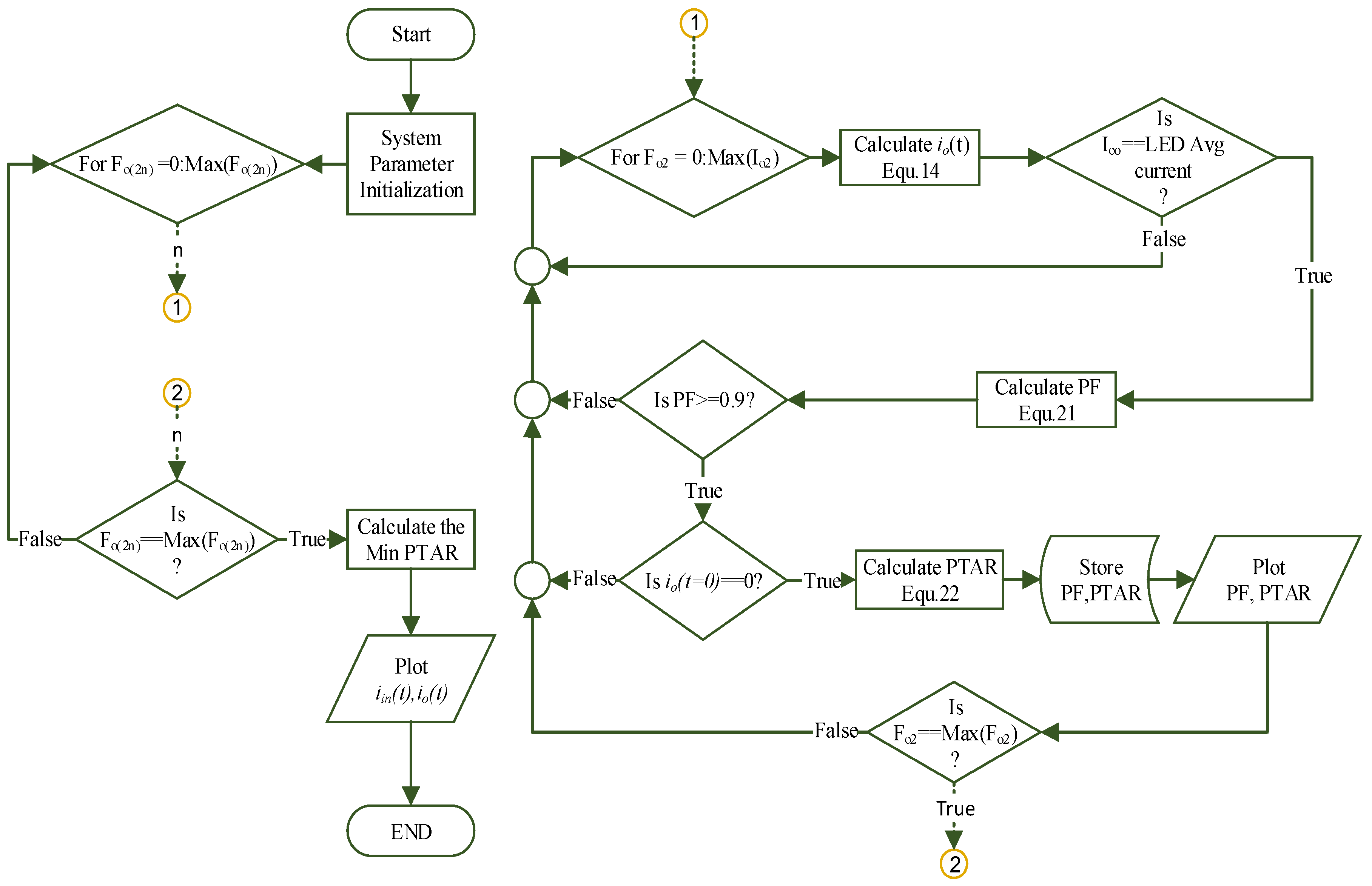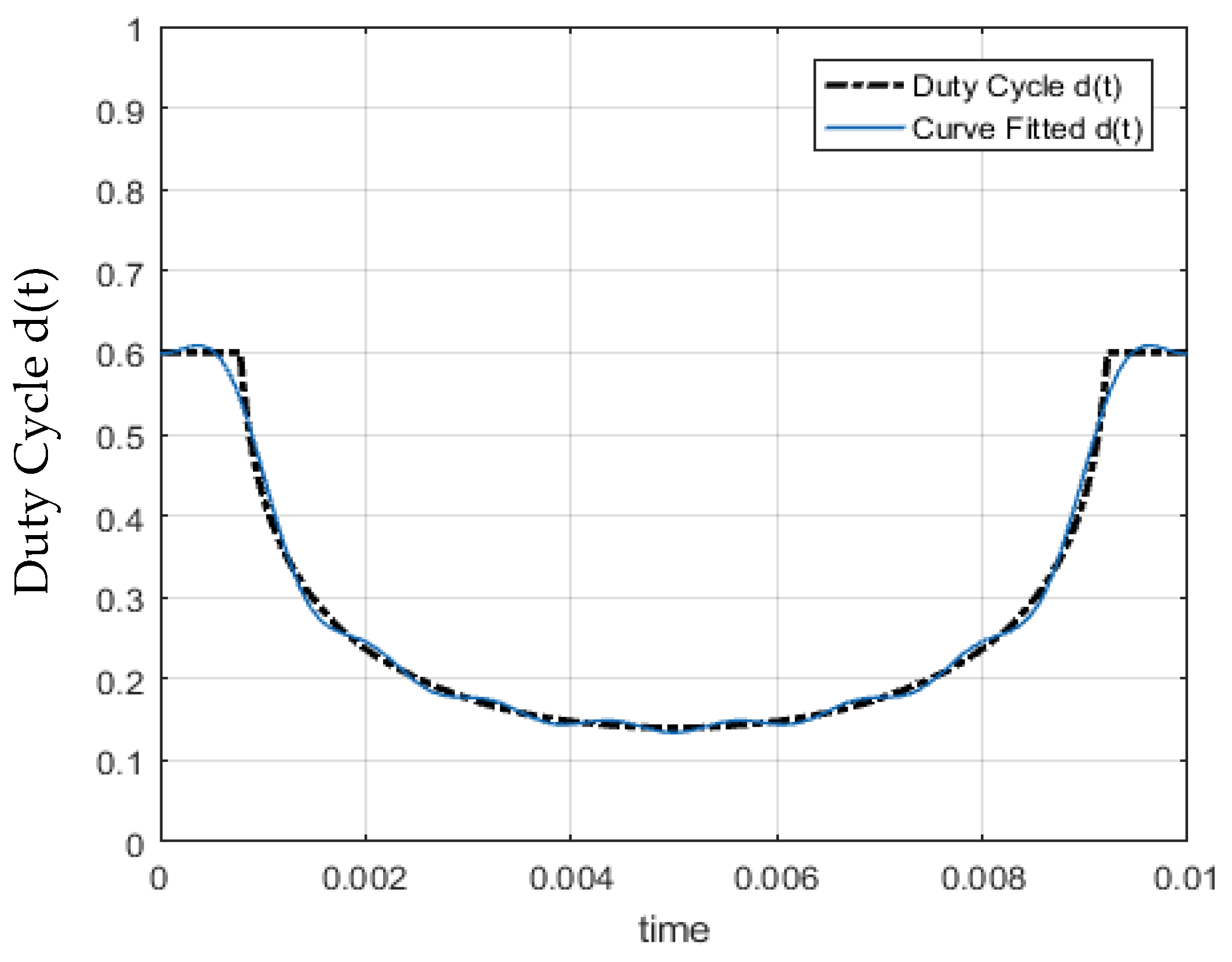Analysis and Control of Electrolytic Capacitor-Less LED Driver Based on Harmonic Injection Technique
Abstract
:1. Introduction
- Using additional control loop circuit to inject harmonics increases the component count. Consequently, the LED lamp cost will increase, limiting its penetration to the market, especially in the case of single-stage solution.
- The best practical result is a PTAR of 1.43 in nominal conditions which is still a high value.
- Using an inaccurate model of the LED chip (i.e., replacing it by a simple resistor), leads to a deviation between the practical results and mathematical ones.
2. Modelling of E-Cap-Less Converter for LED Applications
2.1. Period 1: ( ≤ t ≤ )
2.2. Period 2: ( and )
3. Modeling of Proposed E-Cap Less Converter under Harmonic Injection
3.1. LED Output/Input Currents’ Harmonics Relations
3.2. Designed Operating Regions under Target PF and PTAR
4. Proposed Control Circuit and Simple Implementation
5. Case Study
- Nominal input voltage
- Line frequency
- Output voltage .
- Average output power .
- Output current .
- Switching frequency
- Input filter capacitor
- Input filter inductor
- Output filter capacitor
- Output filter inductor
- Series inductor with LED
5.1. Determination of the Targeted Injected Harmonics’ Order Values
5.2. Design Control Values for Single Multifunction Block (SMFB)
- Integrator for regulation purpose.
- One zero at a frequency lower than one tenth of twice the line frequency to flat the gain and keep the phase angle to zero.
- One pole between the last injected harmonic (>500 Hz, in this case) and one tenth of the switching frequency to filter undesired high frequency harmonics.
6. Simulation & Experimental Results
7. Conclusions
Author Contributions
Funding
Conflicts of Interest
References
- Machine, W. Lifetime of White LEDs; US Department of Energy: Washington, DC, USA, 2009. [Google Scholar]
- Wang, Y.; Alonso, J.M.; Ruan, X. A Review of LED Drivers and Related Technologies. IEEE Trans. Ind. Electron. 2017, 64, 5754–5765. [Google Scholar] [CrossRef]
- Gebreel, A.; Nassary, M.; Bakr, A. Low Cost Low Voltage Low Power Integrated LED Driver; LAP LAMBERT Academic Publishing: Saarbruggen, Germany, 2016. [Google Scholar]
- Cree First to Break 300 Lumens-Per-Watt Barrier. CREE, 26 March 2014. Available online: http://www.cree.com/ (accessed on 2 November 2018).
- Cheng, C.A.; Cheng, H.L.; Chung, T.Y. A Novel Single-Stage High-Power-Factor LED Street-Lighting Driver With Coupled Inductors. IEEE Trans. Ind. Appl. 2014, 50, 3037–3045. [Google Scholar] [CrossRef]
- Fortunato, M. Ensure Long Lifetimes from Electrolytic Capacitors: A Case Study in LED Light Bulbs. Maximintegrated, 29 May 2013. Available online: www.maximintegrated.com (accessed on 2 November 2018).
- Montanari, D.; Saarinen, K.; Scagliarini, F.; Zeidler, D.; Niskala, M.; Nender, C. Film Capacitors for Automotive and Industrial Applications. October 2008. Available online: www.kemet.com (accessed on 2 November 2018).
- Almeida, P.S.; Nogueira, F.J.; Guedes, L.F.A.; Braga, H.A.C. An experimental study on the photometrical impacts of several current waveforms on power white LEDs. In Proceedings of the XI Brazilian Power Electronics Conference, Praiamar, Brazil, 11–15 September 2011; pp. 728–733. [Google Scholar]
- Almeida, P.S.; Bender, V.C.; Braga, H.A.C.; Costa, M.A.D.; Marchesan, T.B.; Alonso, J.M. Static and Dynamic Photoelectrothermal Modeling of LED Lamps Including Low-Frequency Current Ripple Effects. IEEE Trans. Power Electron. 2015, 30, 3841–3851. [Google Scholar] [CrossRef]
- Wang, B.; Ruan, X.; Yao, K.; Xu, M. A Method of Reducing the Peak-to-Average Ratio of LED Current for Electrolytic Capacitor-Less AC–DC Drivers. IEEE Trans. Power Electron. 2010, 25, 592–601. [Google Scholar] [CrossRef]
- Ruan, X.; Yao, B.W.K.; Wang, S. Optimum Injected Current Harmonics to Minimize Peak-to-Average Ratio of LED Current for Electrolytic Capacitor-Less AC–DC Drivers. IEEE Trans. Power Electron. 2011, 26, 1820–1825. [Google Scholar] [CrossRef]
- Gu, L.; Ruan, X.; Xu, M.; Yao, K. Means of Eliminating Electrolytic Capacitor in AC/DC Power Supplies for LED Lightings. IEEE Trans. Power Electron. 2009, 24, 1399–1408. [Google Scholar] [CrossRef]
- Nassary, M.; Orabi, M.; Ahmed, E.; Hasaneen, El.; Gaafar, M. Control Circuit Optimization for Electrolytic Capacitor-Less LED Driver. In Proceedings of the IEEE MEPCON Conference, Cairo, Egypt, 19–21 December 2017. [Google Scholar]
- Lamar, D.G.; Sebastian, J.; Arias, M.; Fernandez, A. On the Limit of the Output Capacitor Reduction in Power-Factor Correctors by Distorting the Line Input Current. IEEE Trans. Power Electron. 2012, 27, 1168–1176. [Google Scholar] [CrossRef]
- Lamar, D.G.; Sebastián, J.; Arias, M.; Fernández, A. Reduction of the Output Capacitor in Power Factor Correctors by Distorting the Line Input Current. In Proceedings of the 2010 Twenty-Fifth Annual IEEE Applied Power Electronics Conference and Exposition (APEC), Palm Springs, CA, USA, 21–25 February 2010; pp. 196–202. [Google Scholar]
- Rezaei, K.; Golbon, N.; Moschopoulos, G. A New Control Scheme for an AC-DC Single-stage Buck-Boost PFC Converter with Improved Output Ripple Reduction and Transient Response. In Proceedings of the APEC 2014, Beijing, China, 10–12 November 2014; pp. 1866–1873. [Google Scholar]
- Soares, G.M.; Alonso, J.M.; Braga, H.A.C. Investigation of the Active Ripple Compensation Technique to Reduce Bulk Capacitance in Off-line Flyback-Based LED Drivers. IEEE Trans. Power Electron. 2018, 33, 5206–5214. [Google Scholar] [CrossRef]
- Soares, G.M.; Almeida, P.S.; Alonso, J.M.; Braga, H.A.C. Capacitance Minimization in Offline LED Drivers Using an Active-Ripple-Compensation Technique. IEEE Trans. Power Electron. 2017, 32, 3022–3033. [Google Scholar] [CrossRef]
- Yang, Y.; Ruan, X.; Zhang, L.; He, J.; Ye, Z. Feed-Forward Scheme for an Electrolytic Capacitor-Less AC/DC LED Driver to Reduce Output Current Ripple. IEEE Trans. Power Electron. 2014, 29, 5508–5517. [Google Scholar] [CrossRef]
- Wang, S.; Ruan, X.; Yao, K.; Tan, S.C.; Yang, Y.; Ye, Z. A Flicker-Free Electrolytic Capacitor-Less AC–DC LED Driver. IEEE Trans. Power Electron. 2012, 27, 4540–4548. [Google Scholar] [CrossRef] [Green Version]
- Lee, K.W.; Hsieh, Y.H.; Liang, T.J. A Current Ripple Cancellation Circuit for Electrolytic Capacitor-less AC-DC LED Driver. In Proceedings of the 2013 Twenty-Eighth Annual IEEE Applied Power Electronics Conference and Exposition (APEC), Long Beach, CA, USA, 17–21 March 2013; pp. 1058–1061. [Google Scholar]
- Shen, Y.C.; Liang, T.J.; Tseng, W.J.; Chang, H.H.; Chen, K.H.; Lu, Y.J.; Li, J.S. Non-Electrolytic Capacitor LED Driver with Feedforward Control. In Proceedings of the IEEE Energy Conversion Congress and Exposition (ECCE), Montreal, QC, Canada, 20–24 September 2015; pp. 3223–3230. [Google Scholar]
- Hui, S.Y.; Li, S.N.; Tao, X.H.; Chen, W.; Ng, W.M. A Novel Passive Offline LED Driver With Long Lifetime. IEEE Trans. Power Electron. 2010, 25, 2665–2672. [Google Scholar] [CrossRef]
- Chen, W.; Li, S.N.; Hui, S.Y.R. A Comparative Study on the Circuit Topologies for Offline Passive LightEmitting Diode (LED) Drivers with Long Lifetime & High Efficiency. In Proceedings of the IEEE Energy Conversion Congress and Exposition, Atlanta, GA, USA, 12–16 September 2010; pp. 724–730. [Google Scholar]
- Kreyszig, E. Advanced Engineering Mathematics, 7th ed.; Wiley: Hoboken, NJ, USA, 1992. [Google Scholar]
- Robert, W. Erickson and Dragan Maksimovic, Fundamentals of Power Electronics, 2nd ed.; Springer Science+Business Media, LLC: New York, NY, USA, 2001. [Google Scholar]
- European Power Supply Manufacturers Association. Harmonic Current Emissions: Guidelines to the Standard EN 61000-3-2; EPSMA: Winchester, UK, 2010. [Google Scholar]
- IEEE Recommended Practices for Modulating Current in HighBrightness LEDs for Mitigating Health Risks to Viewers; IEEE Std: Piscataway, NJ, USA, 2015; pp. 1–80.
















| Harmonics | Case I | Case II | Case III | Case IV | Case V |
|---|---|---|---|---|---|
| PF | 0.983 | 0.979 | 0.963 | 0.9163 | 0.90 |
| PTAR | 2.28 | 1.713 | 1.541 | 1.431 | 1.41 |
| Component | R1 | R2 | C1 | C2 |
|---|---|---|---|---|
| Value | 100 k Ω | 200 k Ω | 1 uF | 220 pF |
© 2018 by the authors. Licensee MDPI, Basel, Switzerland. This article is an open access article distributed under the terms and conditions of the Creative Commons Attribution (CC BY) license (http://creativecommons.org/licenses/by/4.0/).
Share and Cite
Nassary, M.; Orabi, M.; Arias, M.; Ahmed, E.M.; Hasaneen, E.-S. Analysis and Control of Electrolytic Capacitor-Less LED Driver Based on Harmonic Injection Technique. Energies 2018, 11, 3030. https://doi.org/10.3390/en11113030
Nassary M, Orabi M, Arias M, Ahmed EM, Hasaneen E-S. Analysis and Control of Electrolytic Capacitor-Less LED Driver Based on Harmonic Injection Technique. Energies. 2018; 11(11):3030. https://doi.org/10.3390/en11113030
Chicago/Turabian StyleNassary, Mahmoud, Mohamed Orabi, Manuel Arias, Emad M. Ahmed, and El-Sayed Hasaneen. 2018. "Analysis and Control of Electrolytic Capacitor-Less LED Driver Based on Harmonic Injection Technique" Energies 11, no. 11: 3030. https://doi.org/10.3390/en11113030





